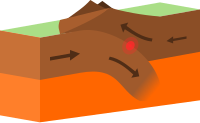
Photo from wikipedia
ABSTRACT The Baneh plutonic complex is situated in the Zagros suture zone of northwest Iran between the Arabian and Eurasian plates. This complex is divided into granite and appinite groups.… Click to show full abstract
ABSTRACT The Baneh plutonic complex is situated in the Zagros suture zone of northwest Iran between the Arabian and Eurasian plates. This complex is divided into granite and appinite groups. Zircon U–Pb dating shows that granites crystallized 41–38 million years ago but appinites experience more protracted magmatic evolution, from at 52 to 38 Ma. Whole-rock chemical compositions show significant major and trace element variations between the two lithologies. Granitic rocks are more evolved, with high contents of SiO2 (62.4–77.0 wt%), low contents of TiO2 (0.25 wt%), MgO (0.05–1.57 wt%), and Fe2O3 (0.40–4.06 wt%) and high contents of Na2O + K2O (≈10 wt%). In contrast, appinites have low contents of SiO2 (51.0–57.0 wt%) and K2O (<2.1 wt%) and high Fe2O3 (6.4–9.35 wt%), MgO (2.0–9.9 wt%), and Mg number (Mg# = 35–76). The concentration of rare earth elements in the appinites is higher than in granitic rocks, making it difficult to form granites solely by fractionation of appinite magma. (87Sr/86Sr)i and εNd(40 Ma) in both groups are similar, from 0.7045 to 0.7061 and −1.2 to +2.6, except for a primitive gabbroic dike with εNd(40 Ma) = +9.9. Appinites show mainly typical I-type characteristics, but granites have some S-type characteristics. The sigmoidal shape of the Baneh pluton and its emplacement into deformed Cretaceous shales and limestone showing kink bands, asymmetric and recumbent folds in a broad contact zone, with pervasive ductile to brittle structures in both host rocks and intrusion, indicate that magma emplacement was controlled by a transpressional tectonic regime, perhaps developed during early stages in the collision of Arabia and Eurasian plates.
Journal Title: International Geology Review
Year Published: 2019
Link to full text (if available)
Share on Social Media: Sign Up to like & get
recommendations!